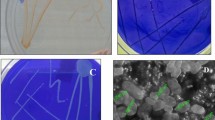Abstract
This work is a study of lipase production by a Brazilian strain ofPenicillium citrinum using an inexpensive and simple medium without organic nitrogen sources and of some important industrial properties, including thermostability in relation to ionic strength. The maximal lipase activity (1585 U/L) was obtained whenPenicillium citrinum was cultured on 0.75% ammonium sulfate complemented with minerals salts instead of yeast extract. Although this activity was about 55% lower than that produced in medium with yeast extract (2850 U/L), the specific activity (7.8 U/mg proteins) was higher than that obtained with the yeast extract (4.9 U/mg proteins). The morphology of fungus changed totally, with yeast extract there are smooth, solid, and spherical pellets whereas on ammonium sulfate there are small “hairy” pellets uniformly suspended in the medium. The effect of ferrous (Fe++) ions was carried out using medium MA with and without Fe++ ions. Lipase production byPenicillium citrinum in medium MA requires Fe++ ions, the absence of which caused a decreased of about 50% in the specific activity (3.5 U/mg proteins). The utilization of commercial, locally available oils as carbon sources, such as soybean oil (236 U/L) and corn oil (74 U/L) resulted in lower activity compared to olive oil, showing that lipase production byPenicillium citrinum is specifically induced by olive oil. Potassium concentration in the medium can effects the production of lipase (1 mM (1585 U/L), 10 mM (1290 U/L), and 30 mM (1238 U/L), 50 mM (195 U/L), and 100 mM (2 U/L). The crude culture filtered was susceptable to thermal deactivation. It was stable at pH 6.0, but was not stable at the optimum pH (8.0-8.5) at 50 mM. At the low ionic concentration (1-25 mM) this lipase was stable at low pH (3.5-4.0). The activation energy was 22.4 ±2.2 Kcal. mol 1.
Similar content being viewed by others
References
Chang, R. C., Chou, S. J., and Shaw, J. F. (1994),Biotechnol. Appl. Biochem. 19, 93–97.
Sakaguchi, K. Takagi, M., Horiuchi, H., and Gomi, K. (1992), InApplied Molecular Genetics of Filamentous Fungi, Kinghorn, J. R. and Turner, G., eds., Blackie Academic and Professional, Glasgow, UK, pp. 75–81.
Maliszewska, I. and Mastalerz, P. (1992),Enzyme Microbiol. Technol. 14, 190–193.
Sztajer, H. and Maliszewska, I. (1989),Biotechnol. Lett. 11, 895–898.
Alhir, S., Markakis, P., and Chandan, R. C. (1990),J. Agric. Food Chem. 38, 598–601.
Arbige, M. V. and Pitcher, W. H. (1989),TIBTECH 7, 331.
Smith, J. and Kristiansen, B. (1993),J. Chem. Tech. Biotechnol. 56, 203–222.
Pimentel, M. C. B., Krieger, N., Coelho, L. C. C. B., Fontana, J. O., Melo, E. H. M., Ledingham, W. M., and LimaFilho J.L., (1994),Appl. Biochem. Biotechnol. 49, 59–73.
Cox, P. W. and Thomas, C. R. (1992),Biotechnol. Bioeng. 39, 945–952.
Nahel,G. (1971), inMethods of Enzymatic Analysis, vol.2, Bergmeyer, H. V. ed. 2, pp. 814–819.
Kwon, D. Y. and Rhee, J. S. (1986),JAOCS,63, 89–92.
Lowry, O. H., Rosenbrough, N. J., Farr, A. L., and Randall, R. J. (1955),J. Biol. Chem. 193, 265–275.
Cooper, T. G. (1977), inThe Tools of Biochemistry, New York, John Wiley & Sons.
Ohnishi, K., Yoshida, Y., and Sekiguchi, J. (1994),J. Ferm. Bioeng. 77, 490–495.
Ishihara, K., Suzuki, T., Yamane, T., and Shimizu, S. (1989),Appl. Microbiol. Biotechnol. 31, 45–48.
Pokorny, D., Friedrich, J. and Cimerman, A. (1994),Biotechnol. Lett. 16, 363–366.
Metz, B. and Kossen, F. (1977),Biotechnol. Bioeng. 19, 781–799.
Haas, M. J., Cichowicz, D. J., and Bailey, D. G. (1992),Lipids 27, 571–576.
Henley, J. P. and Sadana, A. (1986),Biotechnol. Bioeng. 28, 1277–1285.
Sohn, H. S., Chung, S. S., and Rhee, J. S. (1987),Biotechnol. Lett. 9, 117–122.
Cowan, J. A. (1993), inInorganic Biochemistry: An Introduction, VCH, pp. 99–128.
Author information
Authors and Affiliations
Rights and permissions
About this article
Cite this article
Pimentel, M.d.C.B., Melo, E.H.M., Filho, J.L.L. et al. Lipase from a Brazilian StrainPenicillium citrinum Cultured in a Simple and Inexpensive Medium st]Heat-Denaturation, Kinetics, and pH Stability. Appl Biochem Biotechnol 66, 185–195 (1997). https://doi.org/10.1007/BF02788762
Received:
Accepted:
Issue Date:
DOI: https://doi.org/10.1007/BF02788762




